Automated Grading Through Contrastive Learning: A Gradient Analysis and Feature Ablation Approach
Abstract
1. Introduction
2. Related Work
2.1. Static and Dynamic Analysis
2.2. Hybrid Method
2.3. Natural Language Method
2.4. State-of-the-Art Methods
2.5. Proposed Method
3. Design and Methods
3.1. Data Collection
3.2. Data Tokenization and Filtering
3.3. Vocabulary Definition
3.4. Contrastive Model Definition
3.5. Contrastive Model Augmentation and Hyperparameter Optimization
- Learning Rate: The learning rate was varied between 1 × 10−5 and 1 × 10−2, allowing the optimization process to find a balance between convergence speed and stability.
- Embedding Dimension: Embedding dimensions represent the number of values (or features) used to represent each token (word or symbol) in a dense vector space. In natural language processing and machine learning, embedding is a way to encode categorical data (like words, tokens, or characters) into continuous-valued vectors that capture semantic relationships. A smaller embedding dimension might not capture the full complexity of a token’s relationships, leading to a less nuanced model, while a larger dimension may provide more expressive power but also risks overfitting or increased computational cost. The dimensionality of the embeddings was adjusted from 32 to 256, which influences the model’s ability to encapsulate token information in a dense form.
- LSTM Hidden Dimension: Long Short-Term Memory (LSTM) networks are a type of recurrent neural network (RNN) used for sequence modeling. The “hidden dimension” refers to the number of neurons in the hidden layers of the LSTM. These neurons store the state of the network, which helps the LSTM retain information over time (important for tasks like language modeling or sequence prediction). The hidden dimension is crucial in determining the model’s capacity: a smaller hidden dimension (e.g., 32 neurons) may restrict the LSTM’s ability to model complex relationships within data, while a larger dimension (e.g., 256 neurons) can capture more intricate dependencies. Similar to the embedding dimension, the size of the hidden layers varied from 1 to 256, affecting the model’s capacity and complexity.
- Temperature: In contrastive learning, the temperature is a hyperparameter that influences the magnitude of the similarity between positive (correct) and negative (incorrect) pairs in the contrastive loss function. It controls how strongly the model penalizes incorrect predictions in comparison to correct ones. The temperature is typically used in the SoftMax function to scale the logits before calculating the loss, affecting how “hard” or “soft” the decision boundary is between pairs. A higher temperature (e.g., 0.9) leads to a softer distinction between positive and negative pairs, which could help the model generalize better, while a lower temperature (e.g., 0.1) sharpens the distinction, making the model more confident. In our case, varying the temperature between 0.1 and 0.9 explores different levels of contrastive loss sensitivity.
- Augmentation Percentage: Augmentation in this context refers to introducing artificial noise by replacing a portion of tokens in the sequence with a special token (e.g., <UNK> for unknown). This technique helps simulate real-world variability and can enhance the model’s robustness and generalization. By varying the augmentation percentage (from 10% to 50%), the study tests how the model reacts to different levels of noise. A higher augmentation percentage introduces more challenges, encouraging the model to learn more generalized representations, while a lower percentage might allow the model to focus more on learning specific patterns in the data. The percentage of tokens replaced by <UNK> in each sequence was varied from 10% to 50%, testing different levels of noise to understand its impact on model training and generalization.
- Latent representation: A latent representation refers to a learned, lower-dimensional encoding or vector representation of data in a model. This representation captures the underlying, abstract features of the data, which may not be immediately apparent in the raw input but are critical for the model to understand patterns and make predictions. In natural language processing (NLP), the latent representation of a sentence may capture semantic information, such as the overall meaning or intent, rather than individual words. In contrastive learning, such latent representations of positive (correct) and negative (incorrect) pairs are compared to help the model learn to distinguish between similar and dissimilar items.
3.6. Predictive Model Hyperparameter Optimization
3.7. Integrated Gradients
3.8. Feature Ablation
3.9. Code Availability
3.10. Computational Requirements
4. Results and Discussion
4.1. Contrastive Model Training
4.2. Predictive Model Training
4.3. Using Latent Representation in Distance Computation
4.4. Feature Ablation Analysis Indicates Highly Important Tokens in Student Code
4.5. Using Integrated Gradients to Find Impactful Tokens
5. Discussion
6. Conclusions and Future Work
Future Work
Supplementary Materials
Author Contributions
Funding
Data Availability Statement
Conflicts of Interest
References
- Tharmaseelan, J.; Manathunga, K.; Reyal, S.; Kasthurirathna, D.; Thurairasa, T. Revisit of automated marking techniques for programming assignments. In Proceedings of the 2021 IEEE Global Engineering Education Conference (EDUCON), Vienna, Austria, 21–23 April 2021. [Google Scholar] [CrossRef]
- Rößling, G.; Joy, M.; Moreno, A.; Radenski, A.; Malmi, L.; Kerren, A.; Naps, T.; Ross, R.J.; Clancy, M.; Korhonen, A.; et al. Enhancing learning management systems to better support computer science education. ACM SIGCSE Bull. 2008, 40, 142–166. [Google Scholar] [CrossRef]
- Albluwi, I. A closer look at the differences between graders in introductory computer science exams. IEEE Trans. Educ. 2018, 61, 253–260. [Google Scholar] [CrossRef]
- Mekterovic, I.; Brkic, L.; Milasinovic, B.; Baranovic, M. Building a comprehensive automated programming assessment system. IEEE Access 2020, 8, 81154–81172. [Google Scholar] [CrossRef]
- Hollingsworth, J. Automatic graders for programming classes. Commun. ACM 1960, 3, 528–529. [Google Scholar] [CrossRef]
- Insa, D.; Silva, J. Automatic assessment of Java code. Comput. Lang. Syst. Struct. 2018, 53, 59–72. [Google Scholar] [CrossRef]
- Sooksatra, K.; Khanal, B.; Rivas, P.; Schwartz, D.R. Attribution scores of BERT-based SQL-query automatic grading for explainability. In Proceedings of the 2023 International Conference on Computational Science and Computational Intelligence (CSCI), Las Vegas, NV, USA, 13–15 December 2023. [Google Scholar] [CrossRef]
- Rivas, P.; Schwartz, D.R. Modeling SQL Statement Correctness with Attention-Based Convolutional Neural Networks. In Proceedings of the 2021 International Conference on Computational Science and Computational Intelligence (CSCI), Las Vegas, NV, USA, 15–17 December 2021; pp. 64–71. [Google Scholar]
- Paiva, J.C.; Leal, J.P.; Figueira, Á. Automated assessment in computer science education: A state-of-the-art review. ACM Trans. Comput. Educ. 2022, 22, 1–40. [Google Scholar] [CrossRef]
- Kelkar, A.; Relan, R.; Bhardwaj, V.; Vaichal, S.; Khatri, C.; Relan, P. Bertrand-DR: Improving Text-to-SQL using a Discriminative Re-ranker. arXiv 2020, arXiv:2002.00557. [Google Scholar]
- Wang, S.; Pan, S.; Cheung, A. QED: A powerful query equivalence decider for SQL. Proc. VLDB Endow. 2024, 17, 3602–3614. [Google Scholar] [CrossRef]
- He, Y.; Zhao, P.; Wang, X.; Wang, Y. VeriEQL: Bounded equivalence verification for complex SQL queries with integrity constraints. Proc. ACM Program Lang. 2024, 8, 1071–1099. [Google Scholar] [CrossRef]
- Stajduhar, I.; Mausa, G. Using string similarity metrics for automated grading of SQL statements. In Proceedings of the 2015 38th International Convention on Information and Communication Technology, Electronics and Microelectronics (MIPRO), Opatija, Croatia, 25–29 May 2015. [Google Scholar] [CrossRef]
- Bhangdiya, A.; Chandra, B.; Kar, B.; Radhakrishnan, B.; Reddy, K.V.M.; Shah, S.; Sudarshan, S. The XDa-TA system for automated grading of SQL query assignments. In Proceedings of the 2015 IEEE 31st International Conference on Data Engineering, Seoul, Republic of Korea, 13–17 April 2015. [Google Scholar] [CrossRef]
- Chandra, B.; Banerjee, A.; Hazra, U.; Joseph, M.; Sudarshan, S. Automated grading of SQL queries. In Proceedings of the 2019 IEEE 35th International Conference on Data Engineering (ICDE), Macao, 8–11 April 2019. [Google Scholar] [CrossRef]
- Chandra, B.; Joseph, M.; Radhakrishnan, B.; Acharya, S.; Sudarshan, S. Partial marking for automated grading of SQL queries. Proc. VLDB Endow. 2016, 9, 1541–1544. [Google Scholar] [CrossRef][Green Version]
- Chandra, B.; Chawda, B.; Kar, B.; Reddy, K.V.M.; Shah, S.; Sudarshan, S. Data generation for testing and grading SQL queries. VLDB J. 2015, 24, 731–755. [Google Scholar] [CrossRef]
- Chandra, B.; Chawda, B.; Shah, S.; Sudarshan, S.; Shah, A. Extending XData to kill SQL query mutants in the wild. In Proceedings of the Sixth International Workshop on Testing Database Systems, New York, NY, USA, 24 June 2013; ACM: New York, NY, USA, 2013. [Google Scholar] [CrossRef]
- Khurana, D.; Koli, A.; Khatter, K.; Singh, S. Natural language processing: State of the art, current trends and challenges. Multimed. Tools Appl. 2023, 82, 3713–3744. [Google Scholar] [CrossRef] [PubMed]
- Sung, C.; Dhamecha, T.; Saha, S.; Ma, T.; Reddy, V.; Arora, R. Pre-training BERT on domain resources for short answer grading. In Proceedings of the 2019 Conference on Empirical Methods in Natural Language Processing and the 9th International Joint Conference on Natural Language Processing (EMNLP-IJCNLP), Hong Kong, China, 3–7 November 2019; Association for Computational Linguistics: Stroudsburg, PA, USA, 2019. [Google Scholar] [CrossRef]
- Devlin, J.; Chang, M.W.; Lee, K.; Toutanova, K. BERT: Pre-training of deep bidirectional Transformers for language understanding. arXiv 2018, arXiv:1810.04805. [Google Scholar]
- Subakti, A.; Murfi, H.; Hariadi, N. The performance of BERT as data representation of text clustering. J. Big Data 2022, 9, 15. [Google Scholar] [CrossRef]
- Müller, M.; Salathé, M.; Kummervold, P.E. COVID-Twitter-BERT: A natural language processing model to analyse COVID-19 content on Twitter. Front. Artif. Intell. 2023, 6, 1023281. [Google Scholar] [CrossRef] [PubMed]
- Chalkidis, I.; Fergadiotis, M.; Malakasiotis, P.; Aletras, N.; Androutsopoulos, I. LEGAL-BERT: The Muppets straight out of Law School. In Proceedings of the Findings of the Association for Computational Linguistics: EMNLP 2020, Online Event, 16–20 November 2020; pp. 2898–2904. [Google Scholar]
- Abdul Salam, M.; El-Fatah, M.A.; Hassan, N.F. Automatic grading for Arabic short answer questions using optimized deep learning model. PLoS ONE 2022, 17, e0272269. [Google Scholar] [CrossRef]
- Rahaman, M.A.; Mahmud, H. Automated evaluation of handwritten answer script using deep learning approach. Trans. Mach. Learn. Artif. Intell. 2022, 10. [Google Scholar] [CrossRef]
- Maji, S.; Appe, A.; Bali, R.; Chowdhury, A.G.; Raghavendra, V.C.; Bhandaru, V.M. An Interpretable Deep Learning System for Automatically Scoring Request for Proposals. In Proceedings of the 2021 IEEE 33rd International Conference on Tools with Artificial Intelligence (ICTAI), Washington, DC, USA, 1–3 November 2021; pp. 851–855. [Google Scholar]
- Vaswani, A.; Shazeer, N.; Parmar, N.; Uszkoreit, J.; Jones, L.; Gomez, A.N.; Kaiser, Ł.; Polosukhin, I. Attention is all you need. In Proceedings of the 31st International Conference on Neural Information Processing Systems, Long Beach, CA, USA, 4–9 December 2017; pp. 6000–6010. [Google Scholar]
- Wu, Y.; Ma, Y.; Liu, J.; Du, J.; Xing, L. Self-Attention Convolutional Neural Network for Improved MR Image Reconstruction. Inf. Sci. 2019, 490, 317–328. [Google Scholar] [CrossRef]
- Fahim, S.R.; Sarker, Y.; Sarker, S.K.; Sheikh, M.R.I.; Das, S.K. Self attention convolutional neural network with time series imaging based feature extraction for transmission line fault detection and classification. Electr. Power Syst. Res. 2020, 187, 106437. [Google Scholar] [CrossRef]
- Wang, Y.; Gales, M.; Knill, K.; Kyriakopoulos, K.; Malinin, A.; van Dalen, R.; Rashid, M. Towards automatic assessment of spontaneous spoken English. Speech Commun. 2018, 104, 47–56. [Google Scholar] [CrossRef]
- Rivas, P.; Schwartz, D.R.; Quevedo, E. BERT goes to SQL school: Improving automatic grading of SQL statements. In Proceedings of the 2023 Congress in Computer Science, Computer Engineering, & Applied Computing (CSCE), Las Vegas, NV, USA, 24–27 July 2023; pp. 83–90. [Google Scholar]
- Messer, M.; Brown, N.C.; Kölling, M.; Shi, M. How consistent are humans when grading programming assignments? arXiv 2024, arXiv:2409.12967. [Google Scholar]
- Chen, T.; Kornblith, S.; Norouzi, M.; Hinton, G. A simple framework for contrastive learning of visual representations. In Proceedings of the 37th International Conference on Machine Learning, Virtual Event, 13–18 July 2020. [Google Scholar]
- Sundararajan, M.; Taly, A.; Yan, Q. Axiomatic attribution for deep networks. In Proceedings of the 34th International Conference on Machine Learning, Sydney, Australia, 6–11 August 2017; Volume 70, pp. 3319–3328. [Google Scholar]
- Hong, I.; Tran, H.; Donnat, C. A Simplified Framework for Contrastive Learning for Node Representations. In Proceedings of the 2023 57th Asilomar Conference on Signals, Systems, and Computers, Pacific Grove, CA, USA, 29 October–1 November 2023; pp. 573–577. [Google Scholar]
- McInnes, L.; Healy, J.; Saul, N.; Großberger, L. UMAP: Uniform Manifold Approximation and Projection. J. Open Source Softw. 2018, 3, 861. [Google Scholar] [CrossRef]
- Wang, J.; Zhao, Y.; Tang, Z.; Xing, Z. Combining dynamic and static analysis for automated grading SQL statements. J. Netw. Intell. 2020, 5, 179–190. [Google Scholar]
- Shrikumar, A.; Greenside, P.; Kundaje, A. Learning important features through propagating activation differences. In Proceedings of the 34th International Conference on Machine Learning, Sydney, Australia, 6–11 August 2017; Volume 70, pp. 3145–3153. [Google Scholar]
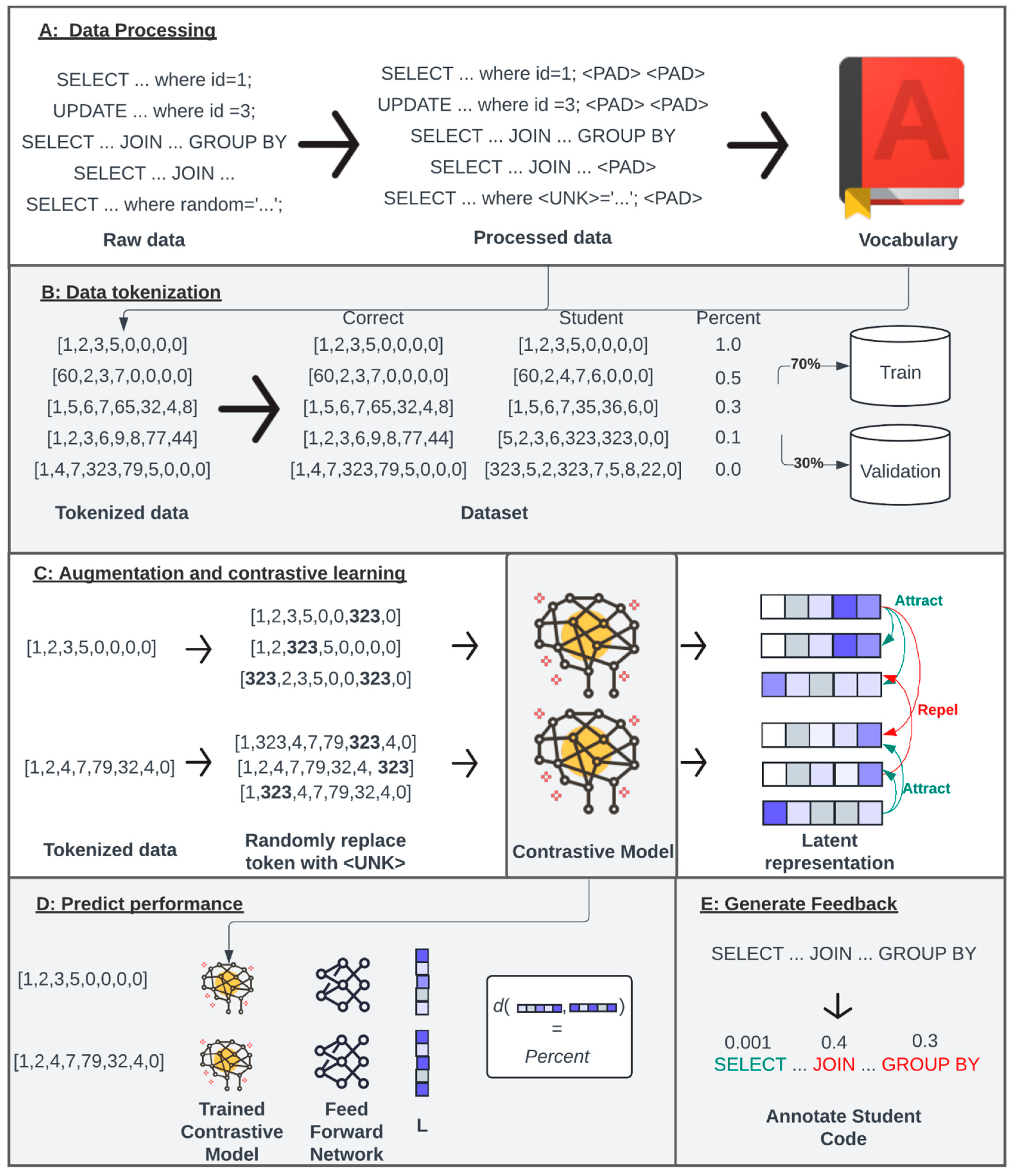
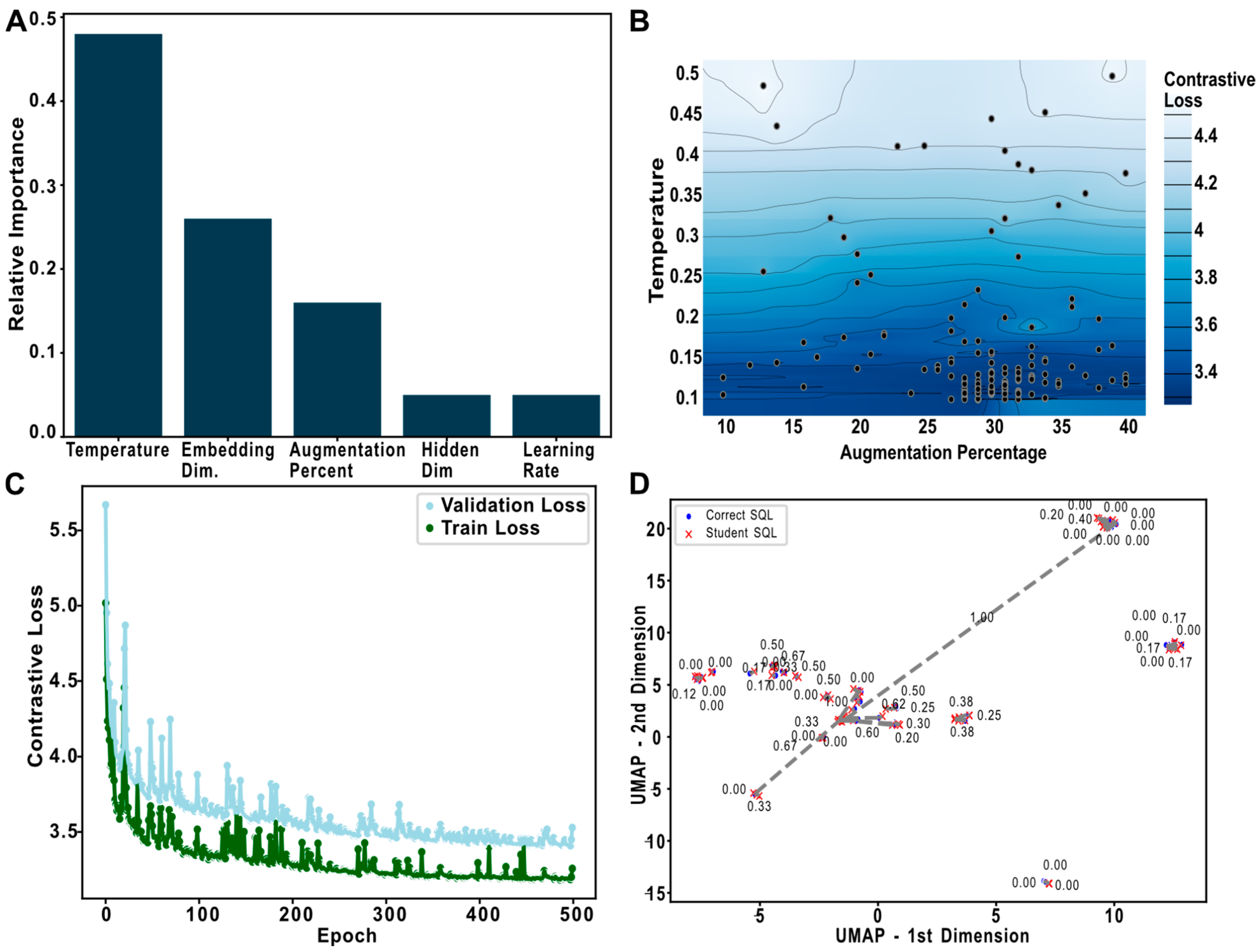
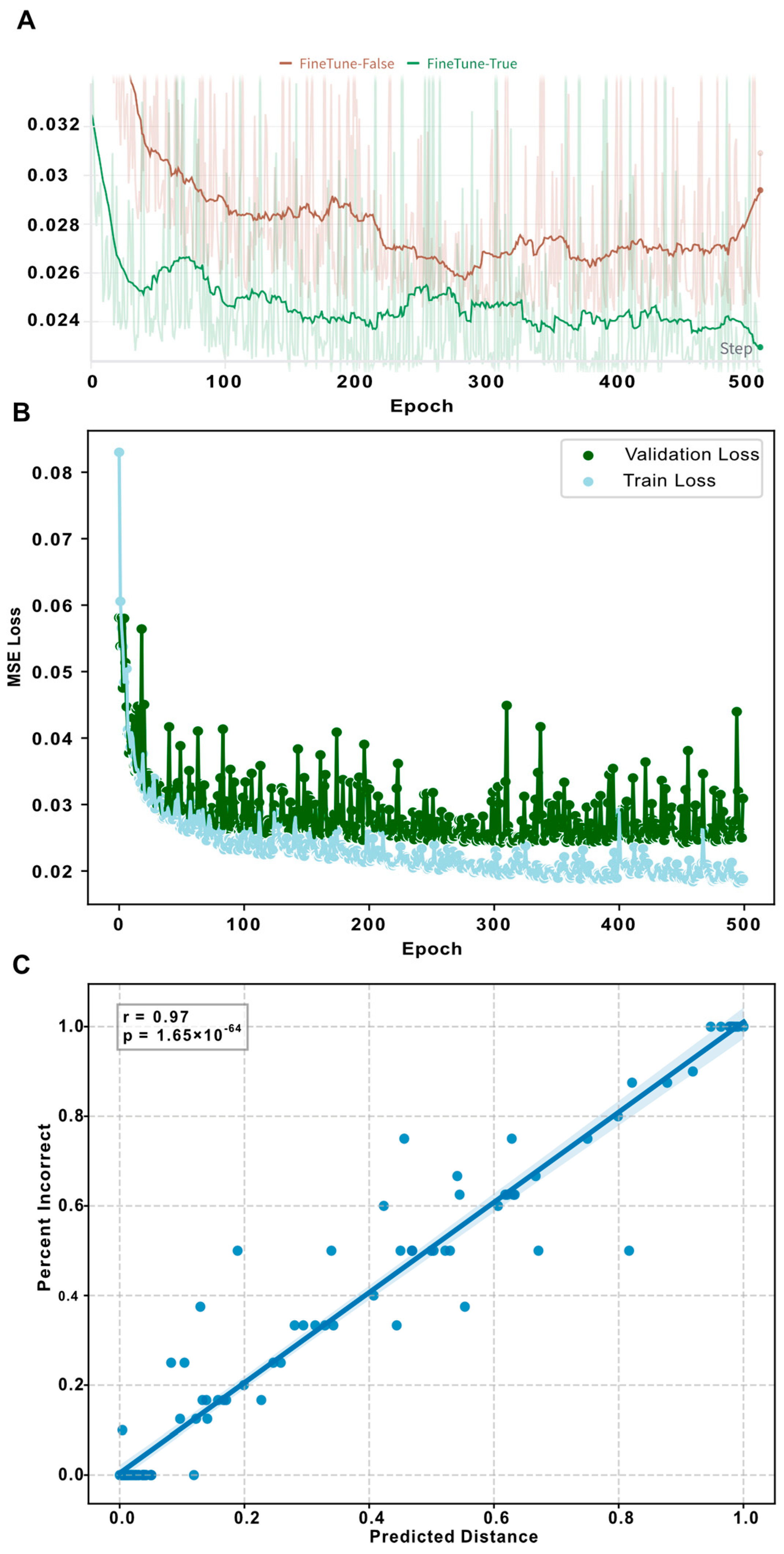
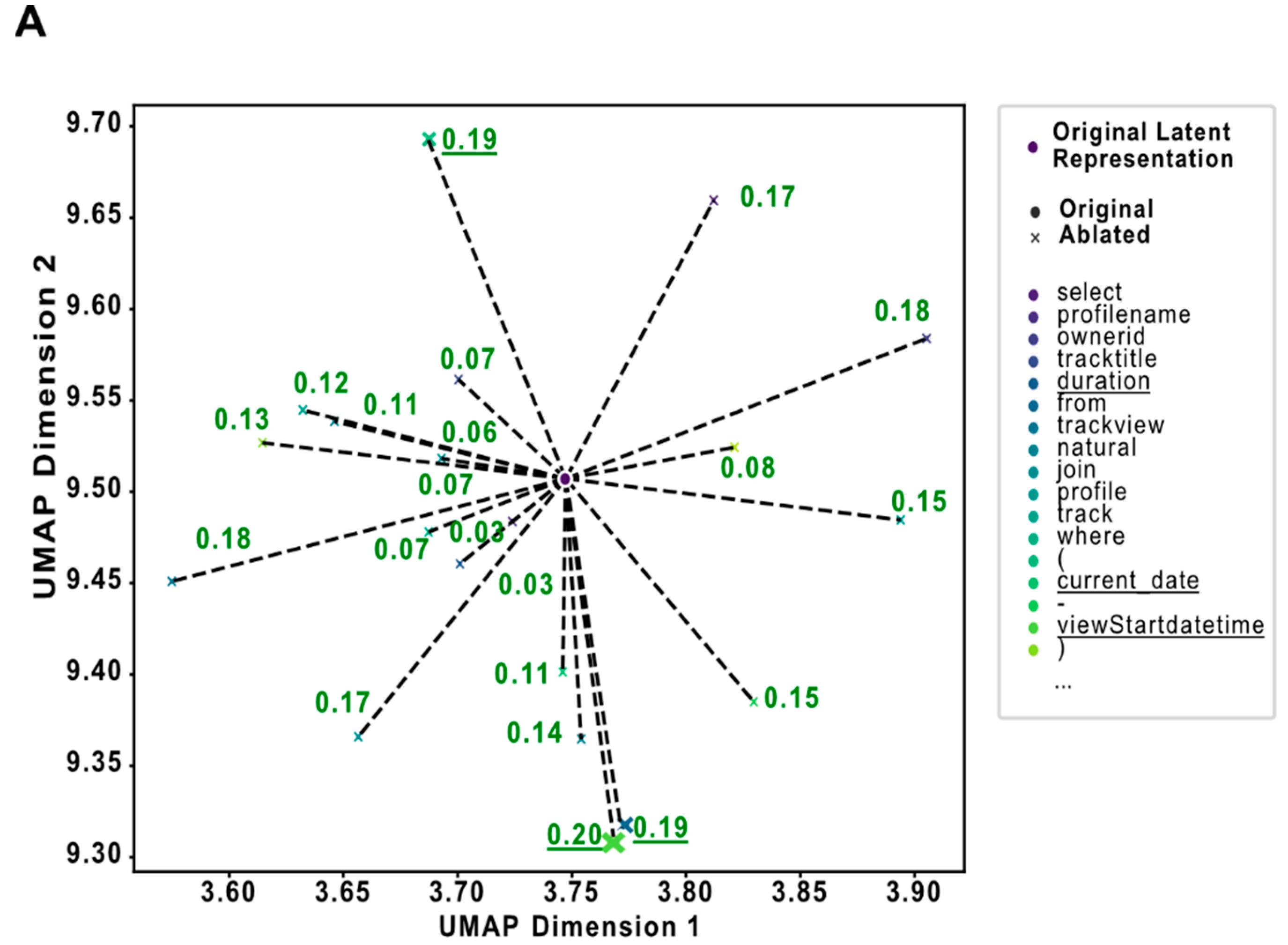
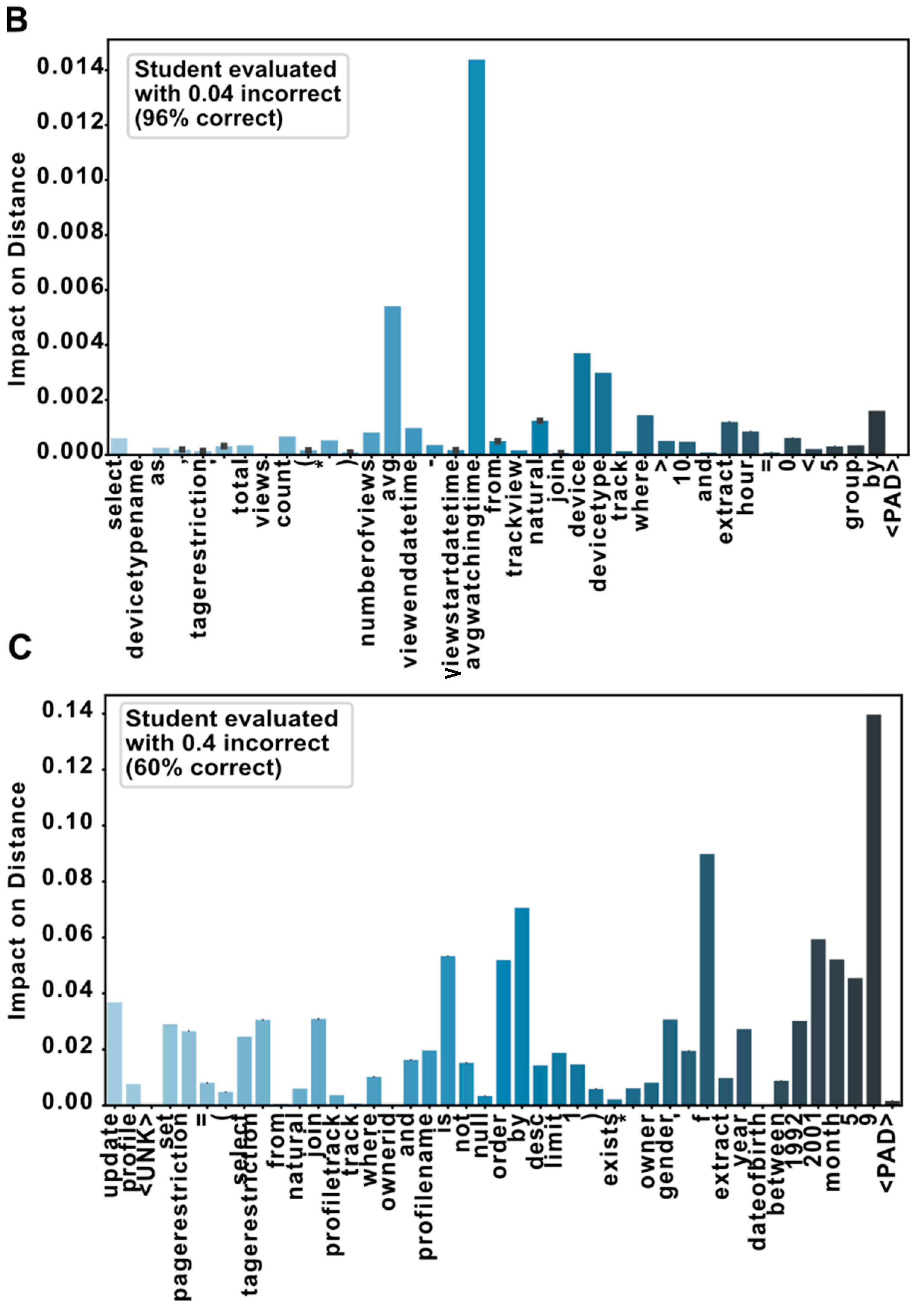
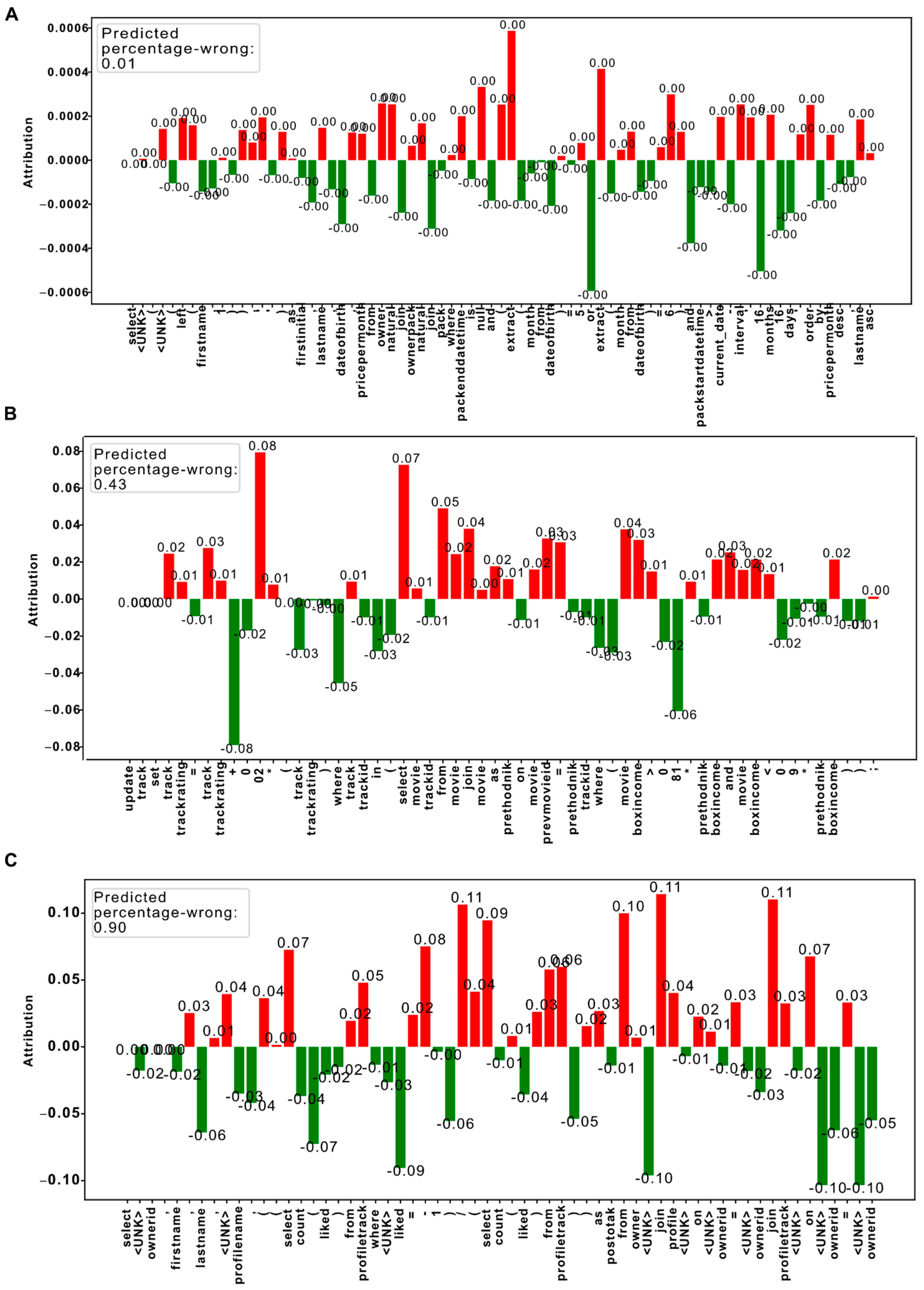
Disclaimer/Publisher’s Note: The statements, opinions and data contained in all publications are solely those of the individual author(s) and contributor(s) and not of MDPI and/or the editor(s). MDPI and/or the editor(s) disclaim responsibility for any injury to people or property resulting from any ideas, methods, instructions or products referred to in the content. |
© 2025 by the authors. Licensee MDPI, Basel, Switzerland. This article is an open access article distributed under the terms and conditions of the Creative Commons Attribution (CC BY) license (https://creativecommons.org/licenses/by/4.0/).
Share and Cite
Sokač, M.; Fabijanić, M.; Mekterović, I.; Mršić, L. Automated Grading Through Contrastive Learning: A Gradient Analysis and Feature Ablation Approach. Mach. Learn. Knowl. Extr. 2025, 7, 41. https://doi.org/10.3390/make7020041
Sokač M, Fabijanić M, Mekterović I, Mršić L. Automated Grading Through Contrastive Learning: A Gradient Analysis and Feature Ablation Approach. Machine Learning and Knowledge Extraction. 2025; 7(2):41. https://doi.org/10.3390/make7020041
Chicago/Turabian StyleSokač, Mateo, Mario Fabijanić, Igor Mekterović, and Leo Mršić. 2025. "Automated Grading Through Contrastive Learning: A Gradient Analysis and Feature Ablation Approach" Machine Learning and Knowledge Extraction 7, no. 2: 41. https://doi.org/10.3390/make7020041
APA StyleSokač, M., Fabijanić, M., Mekterović, I., & Mršić, L. (2025). Automated Grading Through Contrastive Learning: A Gradient Analysis and Feature Ablation Approach. Machine Learning and Knowledge Extraction, 7(2), 41. https://doi.org/10.3390/make7020041








